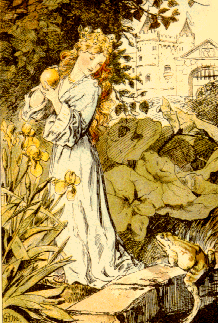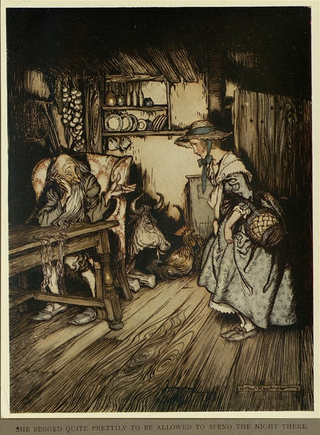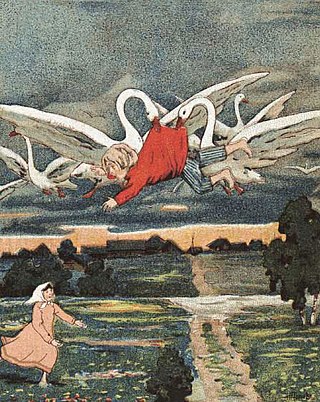The Jezinkas is a Bohemian fairy tale collected by A. H. Wratislaw in his Sixty Folk-Tales from Exclusively Slavonic Sources, number 5. [1] Parker Filmore included it, as Grandfather's Eyes, in Czechoslovak Fairy Tales. [2] Ruth Manning-Sanders included, as Johnny and the Witch-Maidens in both A Book of Witches and A Choice of Magic .
A poor orphan named Johnny (Jeníček) tried to get into service. He travelled far without finding a place. He came to an old man who had caverns in his head instead of eyes, and whose goats were bleating in their stall. The man took him as a goatherd but warned him against the hills: there, the three evil witches, known as the Jezinkas (Jeziňky), would put him to sleep and tear out his eyes.
For two days, Johnny obeyed him, but on the third day, he decided the pasture was better there. He took three shoots of bramble and drove the goats to the hill. A very beautiful and finely-dressed young maiden appeared, offering him an apple; he said he had eaten his fill of apples from his master's apple tree. Another appeared, with a rose, offering to let him smell it; he said he had smelled his fill of the more roses in his master's garden. A third one, who was the youngest and most beautiful of them, offered to comb his hair. He said nothing, but when she came close, he trapped her with the bramble shoot. The other two sisters came and could not undo it, and he then bound them as well despite their protests and weeping.
Johnny fetched his master. Taking the eldest of the Jezinka sisters, he demanded his master's eyes. When she said she did not know, he carried her to the river and threatened to throw her into it. Terrified, she brought him to a cave filled with eyes and gave him two. His master put them in but said he could see nothing but owls. Johnny then did throw the girl into the river and it was the end of her. He did the same with the middle sister, and when she gave his master eyes that saw nothing but wolves, he threw her, too, into the river. With the youngest of the sisters, after she gave his master eyes that saw nothing but pike, he went to drown her as well, but she pleaded with him and gave his master his actual eyes, and so he let her go; she was never seen around again.
The tale is classified in the Aarne-Thompson-Uther Index as tale type ATU 321, "Eyes Recovered from Witch" or "The Stolen Eyes": a poor youth works for an elderly blind couple. The youth discovers the cause for the couple's blindness is due to the actions of evil witches or malevolent fairies. [3] [4]
Scholarship locates variants of type 321 in the Baltic region, in Eastern Europe and in Southern Europe. [5]
The tale type appears merged with tale type ATU 301, "The Three Stolen Princesses", wherein the hero descends to a Lower World (Nether World or Underworld) by following a trail of blood or to rescue three princesses. In this combination, the hero heals the old man (woman or couple)'s eyes and has further adventures (usually tale type ATU 300, "The Dragonslayer"). [6] This combination is reported to exist in Romanian, [7] in East Slavic (in Belarusian and in Russian texts), [8] and in Hungarian variants of the tale type (type 321*, "Vak öregek", translated as "Blind couple" or "The Blind Old Men"). [9] [10]

"The Frog Prince; or, Iron Henry" is a German fairy tale collected by the Brothers Grimm and published in 1812 in Grimm's Fairy Tales. Traditionally, it is the first story in their folktale collection. The tale is classified as Aarne-Thompson type 440.
The Aarne–Thompson–Uther Index is a catalogue of folktale types used in folklore studies. The ATU index is the product of a series of revisions and expansions by an international group of scholars: Originally published in German by Finnish folklorist Antti Aarne (1910), the index was translated into English, revised, and expanded by American folklorist Stith Thompson, and later further revised and expanded by German folklorist Hans-Jörg Uther (2004). The ATU index is an essential tool for folklorists, used along with the Thompson (1932)Motif-Index of Folk-Literature.
The Blue Light is a Brothers Grimm fairy tale about a soldier who finds a magical object that provides him a supernatural helper. Many of the features from Hans Christian Andersen's later work The Tinderbox and from the story of Aladdin and his magic lamp originate with this version. Other tales of this type include The Three Dogs and The Tinderbox.
The Canary Prince is an Italian fairy tale, the 18th tale in Italian Folktales by Italo Calvino. He took the tale from Turin, making various stylistic changes; he noted it developed a medieval motif, but such tales as Marie de France's Yonec produced a rather different effect, being tales of adultery. A variant on Rapunzel, Aarne–Thompson type 310, The Maiden in the Tower, it includes many motifs that differentiate it from that tale. Other fairy tales of this type include Anthousa, Xanthousa, Chrisomalousa, Petrosinella, Prunella, and Rapunzel.
The Brown Bear of Norway is an Irish fairy tale collected by Patrick Kennedy which appeared in his Legendary Fictions of the Irish Celts (1866). It was later included by Andrew Lang in his anthology The Lilac Fairy Book (1910), though Lang misattributed his source as West Highland Tales.
The Grateful Beasts is a Hungarian fairy tale collected by Georg von Gaal in Mährchen der Magyaren (1822). The tale was also published by Hermann Kletke in Märchensaal, Vol II (1845).

"The Nine Peahens and the Golden Apple" is a work of Serbian epic poetry. It is classified as Aarne-Thompson type 400*, "The Swan Maiden", and as Aarne-Thompson-Uther Index (ATU) type 400, "The Quest for the Lost Wife".

"The Hut in the Forest" is a German fairy tale collected by the Brothers Grimm. Andrew Lang included it in The Pink Fairy Book (1897). It is Aarne-Thompson type 431.
Fairy Ointment or "The Fairy Nurse" is an English fairy tale collected by Joseph Jacobs in his English Fairy Tales. It has been told in many variants. Andrew Lang included one in The Lilac Fairy Book.

The Lute Player, The Tsaritsa Harpist or The Tsaritsa who Played the Gusli, is a Russian fairy tale. It was published by Alexander Afanasyev in his collection Russian Fairy Tales, as number 338. Andrew Lang included it in The Violet Fairy Book (1901).

The Sea-Maiden is a Scottish fairy tale collected by John Francis Campbell in Popular Tales of the West Highlands, listing his informant as John Mackenzie, fisherman, near Inverary. Joseph Jacobs included it in Celtic Fairy Tales.

The King of England and his Three Sons is a Romani fairy tale collected by Joseph Jacobs in More English Fairy Tales. He listed as his source Francis Hindes Groome's In Gypsy Tents, where the informant was John Roberts, a Welsh Roma. Groome published the tale as An Old King and his three Sons in England.
The Wicked Sisters is a Russian fairy tale collected by Alexander Afanasyev in Narodnye russkie skazki.

The Magic Swan Geese is a Russian fairy tale collected by Alexander Afanasyev in Narodnye russkie skazki, numbered 113.
Prince Hat under the Ground is the Swedish version of an old Scandinavian fairy tale. The Norwegian version is called East of the Sun and West of the Moon.
The Enchanted Maiden is a Portuguese fairy tale collected by Zófimo Consiglieri Pedroso in Portuguese Folk-Tales.

"The King of the Golden Mountain" is a German fairy tale collected by the Brothers Grimm in Grimm's Fairy Tales.
In folkloristics, "The Animal as Bridegroom" refers to a group of folk and fairy tales about a human woman marrying or being betrothed to an animal. The animal is revealed to be a human prince in disguise or under a curse. Most of these tales are grouped in the international system of Aarne-Thompson-Uther Index under type ATU 425, "The Search for the Lost Husband". Some subtypes exist in the international classification as independent stories, but they sometimes do not adhere to a fixed typing.
Lady Featherflight is an American fairy tale first published in 1891, by W. W. Newell, and collected from an oral source in Cambridge, Massachusetts. In the tale, a traveler is offered hospitality by Lady Featherflight, a giant's daughter. He is forced to perform a number of tasks for her father, but Featherflight offers him assistance through her control over birds. They eventually elope and steal her father's treasure.
The Falcon Pipiristi is a folktale from the Komi people, first published in 1938 in the Russian language. In it, the heroine asks her father to bring an item that belongs to a falcon named Falcon Pipiristi, which she uses to summon him to her bedroom, but her sisters place hooks on the window to hurt him, causing him to fly away. The heroine then goes on a long journey to regain Pipiristi, finding him under the power of a witch, with whom she trades expensive gifts to spend a night in Pipiristi's room. Similar tales have been collected by folklorists from Komi sources.
В белорусском и русском материале также встречается сюжет о пастухе и слепом старике, иногда в составе сказок о подземном царстве - АТ 301.